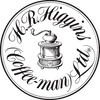All well and good in theory, but what if he’s on the phone? Sure enough, this is exactly what happened while roasting our popular Creole Blend. So, I was left to my own devices. I still remember how hard my heart was pounding as the beans cracked loudly in the roasting drum.
This was on our old Whitmee 28lb roaster, installed in the basement of our shop in South Molton Street. Built in 1936, it was already into its 6th decade. The natural gas burner centred inside the drum supplied the heat. The beans fell through the flames, clearly visible through a fairly large gap at the front. I would insert a small shovel into check on their colour. The aim was for me to keep the gas on until a small curl of smoke appeared in this gap. Then I would need to shut off the gas and let the beans out into the cooling tray. If I left them in too long, they could turn to brittle charcoal or even catch fire. But if taken out too soon, they would look dull and not have the deep full bodied and slightly smoky aftertaste that everyone was expecting.
I waited, and sure enough the curl of smoke was there. I quickly turned off the gas tap and with one last check pulled the lever to set the cooling tray arms turning, yanked out the shutter to divert the airflow from the roasting drum to the cooling tray, pushed up the bar on the chute and stood back as the hot shiny beans rushed out with a big puff of smoke. There they glistened and crackled and my father shot out of the office to survey the scene.
“They look fine” was his only comment. I got the impression he wasn’t all that surprised or worried. But my heart took a while to slow down before I continued with a lighter and far more relaxing roast.
That all happened in 1983 when I was 19 and had been working in South Molton Street full time for a year or so.









